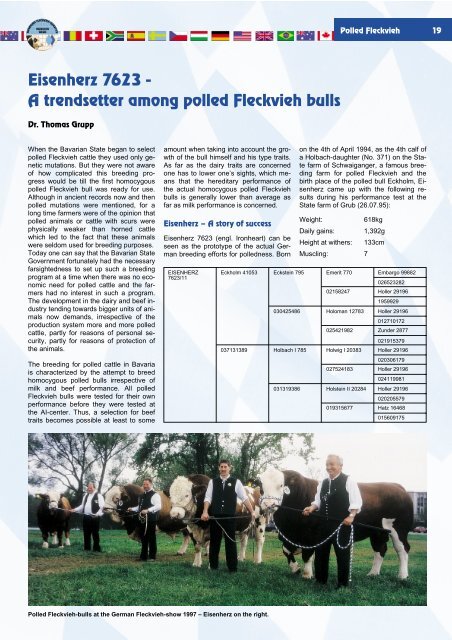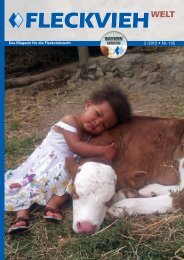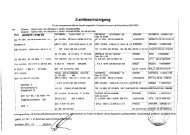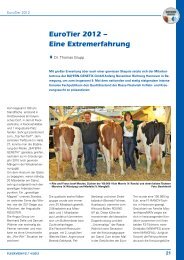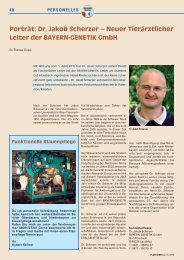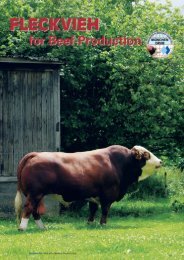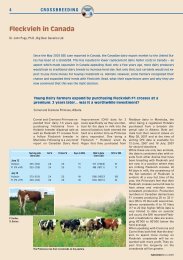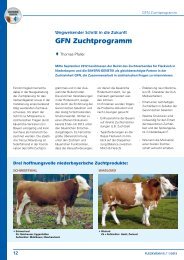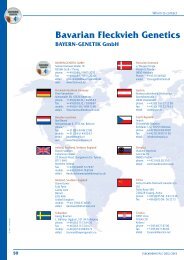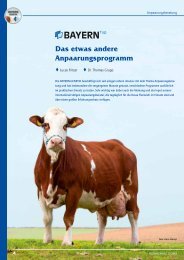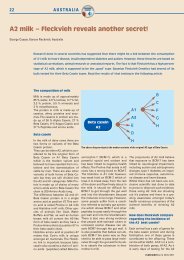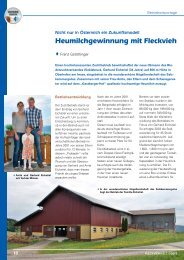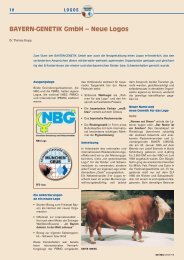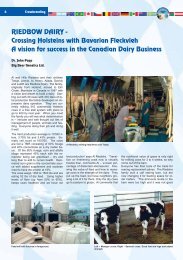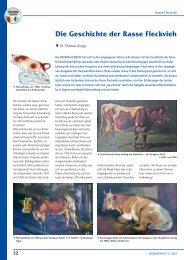Eisenherz 7623 - A trendsetter among polled Fleckvieh bulls
Eisenherz 7623 - A trendsetter among polled Fleckvieh bulls
Eisenherz 7623 - A trendsetter among polled Fleckvieh bulls
Create successful ePaper yourself
Turn your PDF publications into a flip-book with our unique Google optimized e-Paper software.
<strong>Eisenherz</strong> <strong>7623</strong> -<br />
A <strong>trendsetter</strong> <strong>among</strong> <strong>polled</strong> <strong>Fleckvieh</strong> <strong>bulls</strong><br />
Dr. Thomas Grupp<br />
When the Bavarian State began to select<br />
<strong>polled</strong> <strong>Fleckvieh</strong> cattle they used only genetic<br />
mutations. But they were not aware<br />
of how complicated this breeding progress<br />
would be till the first homocygous<br />
<strong>polled</strong> <strong>Fleckvieh</strong> bull was ready for use.<br />
Although in ancient records now and then<br />
<strong>polled</strong> mutations were mentioned, for a<br />
long time farmers were of the opinion that<br />
<strong>polled</strong> animals or cattle with scurs were<br />
physically weaker than horned cattle<br />
which led to the fact that these animals<br />
were seldom used for breeding purposes.<br />
Today one can say that the Bavarian State<br />
Government fortunately had the necessary<br />
farsightedness to set up such a breeding<br />
program at a time when there was no economic<br />
need for <strong>polled</strong> cattle and the farmers<br />
had no interest in such a program.<br />
The development in the dairy and beef industry<br />
tending towards bigger units of animals<br />
now demands, irrespective of the<br />
production system more and more <strong>polled</strong><br />
cattle, partly for reasons of personal security,<br />
partly for reasons of protection of<br />
the animals.<br />
The breeding for <strong>polled</strong> cattle in Bavaria<br />
is characterized by the attempt to breed<br />
homocygous <strong>polled</strong> <strong>bulls</strong> irrespective of<br />
milk and beef performance. All <strong>polled</strong><br />
<strong>Fleckvieh</strong> <strong>bulls</strong> were tested for their own<br />
performance before they were tested at<br />
the AI-center. Thus, a selection for beef<br />
traits becomes possible at least to some<br />
amount when taking into account the growth<br />
of the bull himself and his type traits.<br />
As far as the dairy traits are concerned<br />
one has to lower one’s sights, which means<br />
that the hereditary performance of<br />
the actual homocygous <strong>polled</strong> <strong>Fleckvieh</strong><br />
<strong>bulls</strong> is generally lower than average as<br />
far as milk performance is concerned.<br />
<strong>Eisenherz</strong> – A story of success<br />
<strong>Eisenherz</strong> <strong>7623</strong> (engl. Ironheart) can be<br />
seen as the prototype of the actual German<br />
breeding efforts for <strong>polled</strong>ness. Born<br />
Polled <strong>Fleckvieh</strong>-<strong>bulls</strong> at the German <strong>Fleckvieh</strong>-show 1997 – <strong>Eisenherz</strong> on the right.<br />
Polled <strong>Fleckvieh</strong> 19<br />
on the 4th of April 1994, as the 4th calf of<br />
a Holbach-daughter (No. 371) on the State<br />
farm of Schwaiganger, a famous breeding<br />
farm for <strong>polled</strong> <strong>Fleckvieh</strong> and the<br />
birth place of the <strong>polled</strong> bull Eckholm, <strong>Eisenherz</strong><br />
came up with the following results<br />
during his performance test at the<br />
State farm of Grub (26.07.95):<br />
Weight: 618kg<br />
Daily gains: 1,392g<br />
Height at withers: 133cm<br />
Muscling: 7<br />
EISENHERZ Eckholm 41053 Eckstein 795 Emerit 770 Embargo 99882<br />
<strong>7623</strong>/11<br />
026523282<br />
02158247 Holler 29196<br />
1959929<br />
030425486 Holoman 12783 Holler 29196<br />
012710172<br />
025421982 Zunder 2877<br />
021915379<br />
037131389 Holbach I 785 Holwig I 20383 Holler 29196<br />
020306179<br />
027524183 Holler 29196<br />
024119981<br />
031319386 Holstein II 20284 Holler 29196<br />
020205579<br />
019315677 Hatz 16468<br />
015609175
20 Polled <strong>Fleckvieh</strong><br />
Cow No. 371 – Dam of <strong>Eisenherz</strong> at the age of 9 years on the pasture at Schwaiganger.<br />
Type: 7<br />
Sceletton: 7<br />
Index: 118<br />
Classification: 1<br />
After finishing the performance test he came<br />
to the quarantine stable of the AI-center<br />
of Munich Grub. After 6 weeks of quarantine<br />
and an all round examination he<br />
was sent to the production stable.<br />
Description of the bull <strong>Eisenherz</strong> when<br />
was a young bull:<br />
"Just middle of the road type, balanced,<br />
dark red covered <strong>Fleckvieh</strong> bull with a big<br />
pigmented spot on the right eye. Excellent<br />
connections, slightly built over at the<br />
hind quarter, extraordinary muscling, a<br />
little bit too round. Correct legs, dry fundaments.<br />
The frame is expected to develop<br />
not too much taking into account the<br />
length of the middlehand and the already<br />
well developed neck. The quality of the<br />
transmitted udders should be normal with<br />
respect to the four equally sized scrotum<br />
nipples placed on the abdominal wall and<br />
the scrotum basis. The head expresses<br />
the typical <strong>Fleckvieh</strong>-shape with a strong<br />
tapering to the part. Double eyelid, very<br />
probable to be homocygous.”<br />
<strong>Eisenherz</strong> went through a so called shortened<br />
testing period (September 1996 –<br />
May 1997) with the goal to get about 50<br />
calves from matings with horned cows on<br />
milk recording farms in order to get some<br />
information on the transmission of dairy<br />
traits.<br />
These cows calved from July 1997 to<br />
March 1998.<br />
In the year 1997 <strong>Eisenherz</strong> was presen-<br />
ted to a broad audience at the occasion<br />
of the German <strong>Fleckvieh</strong>-Show and the<br />
meeting of the European <strong>Fleckvieh</strong> breeders<br />
in Ulm. Visitors from all over the<br />
world were impressed by the muscling<br />
and the balance of this bull.<br />
Male Female Alltogether<br />
Polled 17 29 46<br />
Scurs 2 2<br />
Horned<br />
All together 19 29 48<br />
Niece of <strong>Eisenherz</strong> – Dam of the <strong>polled</strong> bull Euro.<br />
Testing for <strong>polled</strong>ness<br />
The calves were tested for <strong>polled</strong>ness at<br />
an age of 2 to 7 weeks. Alltogether 48<br />
calves were examined.<br />
On the 24th of March 1998 it was officially<br />
announced that <strong>Eisenherz</strong> is an homocygous<br />
<strong>polled</strong> bull.<br />
Eye pigmentation<br />
31,2% One eye<br />
22,9% Goggle eye<br />
4,2% Pigmented muzzle<br />
25,0% Pigmented forehead<br />
Body pigmentation<br />
10,4% Darkred<br />
70,8% Red<br />
18,8% Darkyellow<br />
2,1% More white<br />
After it was clear that <strong>Eisenherz</strong> was an<br />
homocygous <strong>polled</strong> bull he was used as<br />
AI-bull all over Germany, but mainly in<br />
suckler cow herds.
Waiting period as natural service<br />
bull<br />
For more than one year, from June 1997<br />
to October 1998 <strong>Eisenherz</strong> was used as<br />
natural service bull on the farm of Mr.<br />
Schreyer from Pfaffenhofen who owns a<br />
suckler cow herd. The Schreyers have an<br />
organic farm which means that it is not allowed<br />
to dehorn the cattle. Via the use of<br />
<strong>polled</strong> genetics the problem of dehorning<br />
cattle could be solved on this farm. Their<br />
<strong>Eisenherz</strong> progeny attract various visitors<br />
from all over the world that are all impressed<br />
by the balanced, excellent muscled<br />
cattle, that are of unique colour. Meanwhile<br />
the <strong>Eisenherz</strong> daughters have been<br />
mated to another <strong>polled</strong> bull of the state<br />
farm of Schwaiganger and now, after calving<br />
show an extraordinary muscling and<br />
nice udders. In contrary to the judged<br />
cattle from the milk recording farms they<br />
surprised with an absolutely stable and<br />
firm conformation.<br />
In autumn 1999 the first <strong>Eisenherz</strong>daughters<br />
calved in the milk recording<br />
dairy farms and came up with quite good<br />
milk performances when you take into<br />
consideration that they derive from a <strong>polled</strong><br />
bull.<br />
Milk value: 74<br />
The beef performance of his male progeny<br />
is not very high as far as the daily<br />
gains are concerned, nevertheless the<br />
beef percentage (with 1,59%) and the<br />
grading of the carcass of his sons are tremendous.<br />
These values derive from progeny<br />
from the testing period. Meanwhile<br />
the results from the beef breeding industry<br />
confirm this beef value. <strong>Eisenherz</strong><br />
has the highest beef value of all fullblood<br />
<strong>polled</strong> <strong>bulls</strong> in Germany with a beef value<br />
of 118.<br />
Excellent <strong>Eisenherz</strong>-calf from Canada.<br />
Polled <strong>Fleckvieh</strong> 21<br />
Champion heifer on the Windhoek-Show – Wonderful <strong>Eisenherz</strong> daughter from the Riedels /<br />
Gobabis.<br />
<strong>Eisenherz</strong>-son Sako – Junior Champion Bull Pretoria 2000<br />
Breeder: van Rendsburg / South Africa<br />
Echo (V:<strong>Eisenherz</strong>) – Champion bull from Brandenburg / Mecklenburg-Vorpommern / Germany.
22 Polled <strong>Fleckvieh</strong><br />
Beef value: 118 (+8 net gain, + 1,59%<br />
beef, +9,3 classification EUROP)<br />
The judging of the progeny had an surprising<br />
result. The relative figure for frame<br />
was 91, which confirmed the assumption<br />
that the progeny would be more middle of<br />
the road type size. But as far as muscling<br />
is concerned the <strong>Eisenherz</strong>-daughters<br />
reached excellent breeding values with<br />
126 points, a figure that is reached only<br />
quite seldom. As far as the type traits are<br />
concerned with a breeding value of 89 the<br />
progeny show a lot of balance and type,<br />
but as far as the conformation is concerned<br />
a weak fatlock and a sickled hock have<br />
to be mentioned. The good udders are<br />
very surprising for a <strong>polled</strong> bull, since there<br />
is little room for selection on the female<br />
side of <strong>polled</strong> cows. Because of these<br />
very positive characteristics <strong>Eisenherz</strong><br />
was used a lot in dual purpose farms that<br />
have to attach a lot of importance to the<br />
quality of the udder.<br />
<strong>Eisenherz</strong> is well known all over<br />
the world<br />
Because of his extraordinary type traits,<br />
pedigree and the colour of his coat semen<br />
and embryos from <strong>Eisenherz</strong> have<br />
been used in the following countries:<br />
● Germany<br />
● Austria<br />
● Luxembourg<br />
● Sweden<br />
● Scottland<br />
● Israel<br />
● Canada<br />
● USA<br />
● Mexico<br />
● Paraguay<br />
<strong>Eisenherz</strong> full sisters from Namibia – Breeders: Mr. and Mrs. Riedel.<br />
● Australia<br />
● New Zealand<br />
● South Africa<br />
● Namibia<br />
Despite of a quite small number of progeny<br />
in the buyer countries the bull impressed<br />
all breeders. Meanwhile some<br />
sons of <strong>Eisenherz</strong> are used as natural<br />
service <strong>bulls</strong> and some were even bought<br />
from AI-centers. His progeny impressed<br />
at national and international shows. In the<br />
year 2001 an <strong>Eisenherz</strong>-son was sold in<br />
Canada Bar 5 Mr. <strong>Eisenherz</strong> for 31.000<br />
Can$. Even if they get huge offers the<br />
owners of <strong>Eisenherz</strong> progeny often don’t<br />
want to give away these genetics.<br />
His secure hereditary performance regarding<br />
<strong>polled</strong>ness and beef performance,<br />
the very good nature even though the bull<br />
is <strong>polled</strong>, the middle of the road type fra-<br />
me and the high percentage of red and<br />
covered animals will probably make <strong>Eisenherz</strong><br />
the most important <strong>polled</strong> <strong>Fleckvieh</strong><br />
bull worldwide. Via his sons and<br />
daughters a wide spread of Bavarian <strong>polled</strong><br />
genetics seems to be sure.<br />
Whereas in beef producing countries <strong>polled</strong><br />
<strong>Fleckvieh</strong> <strong>bulls</strong> are mainly used for<br />
the improvement of beef performance, in<br />
Germany <strong>polled</strong> <strong>Fleckvieh</strong> <strong>bulls</strong> are often<br />
used in dual purpose herds to import the<br />
gene for <strong>polled</strong>ness. It will be very important<br />
in future to make the genetic basis of<br />
the <strong>polled</strong> cattle independent from the Hand<br />
E –lines, to stabilize the genes for<br />
milk performance and to breed cows with<br />
good type traits and particularly cows with<br />
udders of good quality.<br />
<strong>Eisenherz</strong> has proven to be a good basis<br />
– and now gives further impulses to the<br />
breeding of <strong>polled</strong> <strong>Fleckvieh</strong>.<br />
<strong>Eisenherz</strong>-daughters bred by Jan Hattingh / South Africa. Two very typical <strong>Eisenherz</strong>-daughters of the farm of the Schreyers/<br />
Germany – all progeny of <strong>Eisenherz</strong> look like this.


